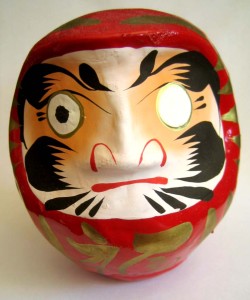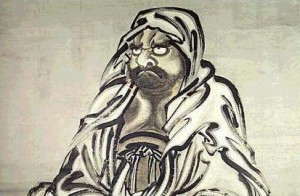 The Chinese term Ch’an (Japanese reading: Zen) or Ch’an-na is a phonetic rendering of the Sanskrit Dhyana, which is usually translated in English as meditation. The traditional account of the origin of the Ch’an or Zen school is that the Buddha, in addition to his scriptures, possessed an esoteric teaching that was transmitted independently of written texts. This teaching he transmitted personally to one of his disciples, who in turn transmitted it to his own disciple. In this way, it was handed down until it reached Bodhidharma, who is supposed to have been the twenty-eighth Patriarch in India, and who came to China some time between 520 and 526, where he became the first Patriarch (ancestor) of the Ch’an school in China.
The Chinese term Ch’an (Japanese reading: Zen) or Ch’an-na is a phonetic rendering of the Sanskrit Dhyana, which is usually translated in English as meditation. The traditional account of the origin of the Ch’an or Zen school is that the Buddha, in addition to his scriptures, possessed an esoteric teaching that was transmitted independently of written texts. This teaching he transmitted personally to one of his disciples, who in turn transmitted it to his own disciple. In this way, it was handed down until it reached Bodhidharma, who is supposed to have been the twenty-eighth Patriarch in India, and who came to China some time between 520 and 526, where he became the first Patriarch (ancestor) of the Ch’an school in China. Zen tradition represents Bodhidharma as a fierce-looking fellow with a bushy beard and wide-open, penetrating eyes – in which, however, there is just the hint of twinkle. A legend says that he once fell asleep in meditation and was so furious that he cut off his eyelids, and falling to the ground they arose as the first tea plant. Tea has thereafter supplied Zen monks with a protection against sleep, and so clarifies and invigorates the mind that it has been said, “The taste of Zen [ch’an] and the taste of tea [ch’a] are the same,” another legend holds that Bodhidharma sat so long in meditation that his legs fell off. Hence the delightful symbolism of those Japanese Daruma dolls which represent Budhidharma is a legless roly-poly so weighted inside that he always stands up again when pushed over. A popular Japanese poem says of the Daruma doll:
Zen tradition represents Bodhidharma as a fierce-looking fellow with a bushy beard and wide-open, penetrating eyes – in which, however, there is just the hint of twinkle. A legend says that he once fell asleep in meditation and was so furious that he cut off his eyelids, and falling to the ground they arose as the first tea plant. Tea has thereafter supplied Zen monks with a protection against sleep, and so clarifies and invigorates the mind that it has been said, “The taste of Zen [ch’an] and the taste of tea [ch’a] are the same,” another legend holds that Bodhidharma sat so long in meditation that his legs fell off. Hence the delightful symbolism of those Japanese Daruma dolls which represent Budhidharma is a legless roly-poly so weighted inside that he always stands up again when pushed over. A popular Japanese poem says of the Daruma doll:
Ya oki,
Such is life—
Seven times down,
Eight times up!
Bodhidharma’s alleged interview with the Emperor Wu of Liang is typical of his abrupt and direct manner. For the Emperor described all that he had done to promote the practice of Buddhism, and asked what merit he had gained thereby – taking the popular view that Buddhism is a gradual accumulation of merit through good deeds, leading to better and better circumstances in future lives, and finally to nirvana. But Bodhidharma replied, “No merit whatever!” this so undermined the Emperor’s idea of Buddhism that he asked, “What, then, is the sacred doctrine’s first principle?” Budhidharma replied, “It’s just empty; there is nothing sacred.” Who, then, are you,” said the emperor, “to stand before us?” “I don’t know.”
After this interview, so unsatisfactory from the emperor’s point of view, Bodhidharma retired to a monastery in Wei, where he is said to have spent nine years in a cave, “Gazing at the wall”. He remained until he was approached by the monk Hui-k’o (486-593 may be!) who was to become Bodhidharma’s successor as the second Patriarch.
Hui-k’o again and again asked Bodhidharma for instruction, but was always refused. Yet he continued to sit in meditation outside the cave, waiting patiently in the snow in the hope that Bodhidharma would at least relent. In desperation he finally cut off his left arm and presented it to Bodhidharma as a token of his agonized sincerity. At this Bodhidharma at least asked Hui-k’o what he wanted.
“I have no peace of mind,” Said Hui-k’o. “Please pacify my mind.”
“Bring out your mind here before me,” replied Bodhidharma, “and I will pacify it!”
“But when I seek my own mind,” said Hui-k’o, “I cannot find it.”
“There!” snapped Bodhidharma, “I have pacified your mind!”
At this moment Hui-k’o had his awakening so that this interchange purports to be the first instance of what became the characteristic Zen method of instruction or “question-and-answer,” sometimes loosely called the “Zen story.” The greater part of Zen literature consists of these anecdotes, many of them much more puzzling than this, and their aim is always to precipitate some type of sudden realization in the questioner’s mind, or to test the depth of his insight. For this reason, such anecdotes cannot be “explained” without spoiling their effect. In some respects they are like jokes which do not produce their intended effect of laughter when the “punch line” requires further explanation. One must see the point immediately, or not at all.
Source: The way of Zen, by: Alan W. Watts

